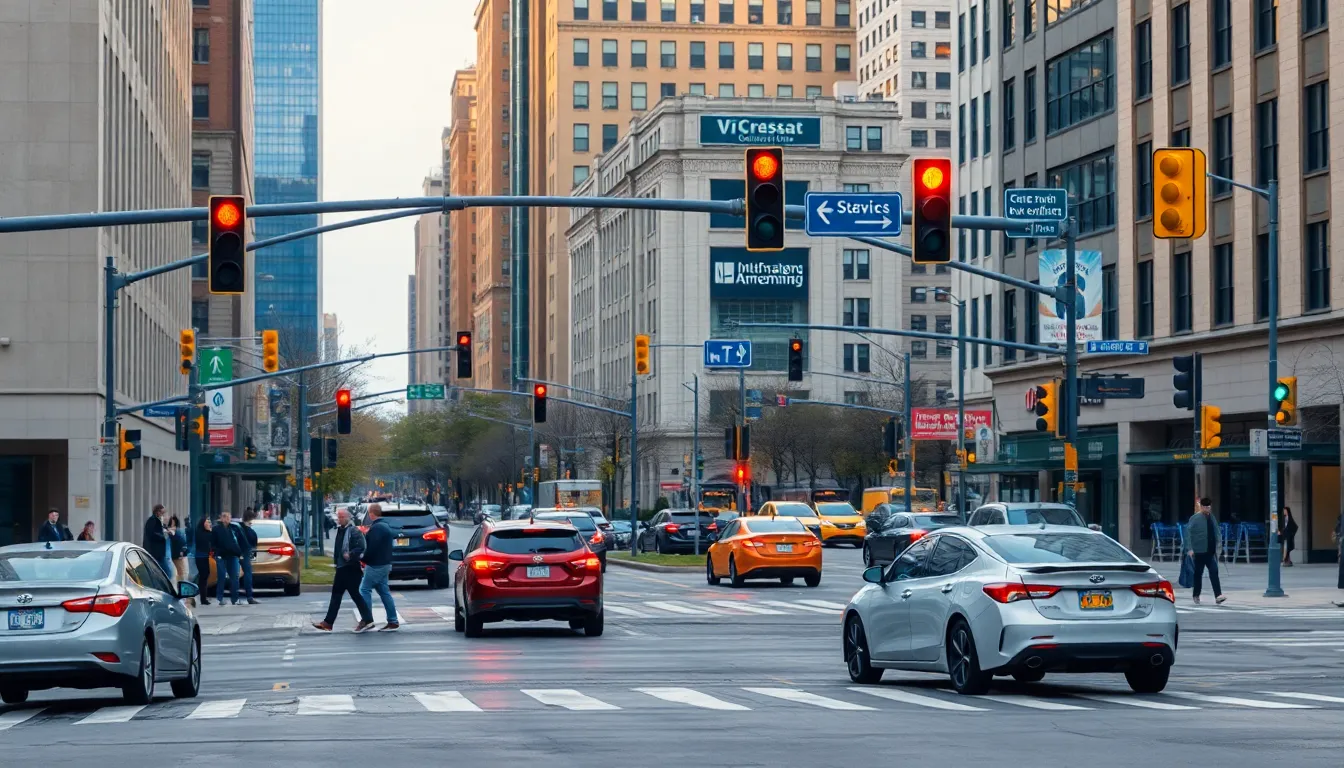Imagine a world where traffic jams are nothing more than a distant memory, and rush hour feels more like a leisurely stroll. With the Internet of Things (IoT) stepping into the spotlight, this dream is closer than ever. From smart traffic lights that adjust to real-time conditions to sensors that communicate with vehicles, IoT is revolutionizing how cities manage traffic flow.
Table of Contents
ToggleOverview of IoT for Traffic Control
IoT technology enhances traffic control by integrating connected devices into urban infrastructure. Smart traffic signals respond to real-time data, adjusting timing based on vehicle flow and pedestrian needs. Sensors placed along roads collect extensive data on traffic patterns, supporting efficient management.
Connected vehicles communicate with traffic systems, reporting conditions and enabling adaptive responses. Data analytics processes information collected from sensors, allowing city planners to identify congestion hotspots and develop targeted improvements. Cloud computing supports this ecosystem by providing robust storage and processing capacity.
Collaborative efforts between city authorities and tech companies drive the deployment of IoT solutions. Implementations include smart parking systems that guide drivers to available spots, minimizing search times and reducing emissions. Furthermore, smart traffic management systems facilitate emergency vehicle prioritization, improving response times.
Real-world examples illustrate effective IoT traffic solutions. In several cities, connected infrastructure has led to a notable decrease in traffic delays. Reports show that major urban centers adopting these technologies experienced a reduction in travel times by up to 25 percent.
Investments in IoT infrastructure promise long-term benefits. Enhanced traffic management systems contribute to reduced accidents, improved air quality, and higher overall productivity. Urban environments become more navigable as these systems optimize traffic flow and reduce congestion.
Benefits of IoT in Traffic Management
IoT technology revolutionizes traffic management, offering numerous advantages that enhance urban mobility.
Enhanced Traffic Flow
Smart traffic signals adapt to current vehicle volumes and pedestrian needs. These signals dynamically adjust their timing, reducing wait times at intersections. Data from sensors provides real-time insights, allowing systems to prioritize lanes based on traffic demand. Cities implementing IoT-enabled traffic solutions report smoother commutes, decreasing stop-and-go situations. Organizations integrating connected vehicles into the infrastructure further improve traffic flow. As a result, overall travel efficiency increases, contributing to a noticeable decline in congestion.
Real-Time Data Analysis
Real-time data from IoT sensors transforms traffic management strategies. Analyzing this data allows city planners to identify congestion hotspots quickly. Immediate insights facilitate timely responses to traffic patterns, helping to mitigate potential delays. Furthermore, predictive analytics based on historical data offers cities the ability to anticipate traffic peaks. This proactive approach aids authorities in optimizing resource allocation and implementing effective traffic measures. Cities equipped with advanced analytics tools find it easier to manage traffic in dynamic situations, ultimately enhancing the commuter experience.
Challenges in Implementing IoT Solutions
Implementing IoT solutions in traffic control presents various challenges that city planners must navigate.
Infrastructure Limitations
City infrastructure often lacks the necessary components to support IoT systems. Many urban areas feature outdated traffic signals incapable of integration with smart technologies. These limitations hinder the deployment of innovative traffic management solutions. Funding constraints also contribute to the difficulty in upgrading existing infrastructure. In cases where cities invest in IoT systems, the absence of reliable internet connectivity can further complicate data transmission. Consequently, collaboration between municipal authorities and technology providers becomes essential for bridging these gaps. Addressing infrastructure limitations requires strategic planning and investment to ensure compatibility with advanced IoT technologies.
Data Privacy Concerns
Data privacy constitutes a significant challenge when deploying IoT solutions for traffic control. Collecting real-time data from connected vehicles and sensors raises security concerns regarding personal information. Protecting user data requires robust encryption and strict access controls to prevent unauthorized access. Furthermore, regulations such as the General Data Protection Regulation (GDPR) impose additional compliance obligations on cities. Residents may express apprehension about constant surveillance and data collection initiatives. Establishing transparent policies that inform citizens about data usage and purpose helps alleviate these concerns. Promoting trust through effective communication can enhance community support for IoT traffic solutions.
Case Studies of Successful IoT Implementation
Numerous cities have effectively utilized IoT technology to enhance traffic control. City A and City B showcase innovative approaches, leading to improved traffic management.
City A: Smart Traffic Lights
City A installed smart traffic lights that adjust in real-time based on vehicle and pedestrian activity. These adaptive systems analyze data from numerous sensors, creating optimal signal timing. As a result, the city recorded a 30 percent reduction in waiting times at intersections. The project, backed by local tech partnerships, also enabled emergency vehicles to receive priority, enhancing response times. Through continuous data collection, city planners can reevaluate and refine traffic management strategies, ensuring the systems evolve alongside urban growth.
City B: Connected Vehicles
In City B, connected vehicles communicate with centralized traffic systems, sharing vital information about road conditions. These real-time updates guide the traffic control center in making informed decisions that alleviate congestion. By integrating vehicle data, the city reduced traffic delays by 20 percent during peak hours. Automated alerts to drivers about upcoming incidents improved route planning and minimized frustration. Collaboration with automotive manufacturers made this initiative possible, illustrating the significance of cross-sector partnerships in advancing smart city solutions.
Future Trends in IoT for Traffic Control
Smart traffic management systems are set to evolve further with advancements in IoT technology. Enhanced integration of artificial intelligence in traffic signals allows for predictive analytics, enabling cities to anticipate traffic patterns and alter signal timings effectively. Increased reliance on machine learning algorithms can lead to more precise traffic forecasts, ensuring smoother commutes for all users.
Many cities plan to implement vehicle-to-everything (V2X) communication, allowing connected vehicles to share real-time data with other road users as well as traffic management systems. This system can reduce accidents and improve overall safety by informing drivers of potential hazards ahead. Improvements in cloud computing technology will also support larger data storage capabilities, enhancing real-time data analysis.
Smart parking solutions represent another vital trend. Cities increasingly adopt IoT-enabled parking meters that guide drivers to available spaces, thereby minimizing traffic congestion caused by searching for parking. Expanded use of mobile applications for parking reservations can significantly streamline the parking experience.
Urban planners are also focusing on integrating multimodal transportation solutions. By leveraging IoT, cities can connect various transport modes, such as buses, bicycles, and rideshares, to provide residents with more efficient and flexible travel options. Increased investment in fiber optics and 5G technology will further support faster and more reliable communication between connected devices.
Sustainable practices are becoming more prevalent within traffic control systems. Cities aim to incorporate eco-friendly transportation options that reduce carbon footprints. As IoT solutions become widespread, cities can gather insights that promote greener traffic patterns, resulting in improved air quality.
Rising public-private partnerships will drive future IoT innovations in traffic management. Collaboration between city officials, technology firms, and data analysts is essential for developing effective systems that address unique urban challenges. These partnerships are crucial for fostering trust, ensuring transparency, and enhancing user engagement with IoT traffic solutions.
Conclusion
The integration of IoT technology into traffic control systems is reshaping urban mobility. By leveraging real-time data and smart infrastructure, cities can enhance traffic flow and reduce congestion. This transformation not only improves commute times but also contributes to safer and more sustainable urban environments.
As cities continue to invest in IoT solutions, the potential for innovation grows. Future advancements in artificial intelligence and vehicle-to-everything communication promise to further optimize traffic management. Collaborative efforts among city authorities and technology providers will be essential in overcoming existing challenges and ensuring the successful implementation of these systems.
Ultimately, embracing IoT for traffic control can lead to a more efficient, reliable, and eco-friendly transportation network, benefiting both residents and the environment.





